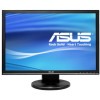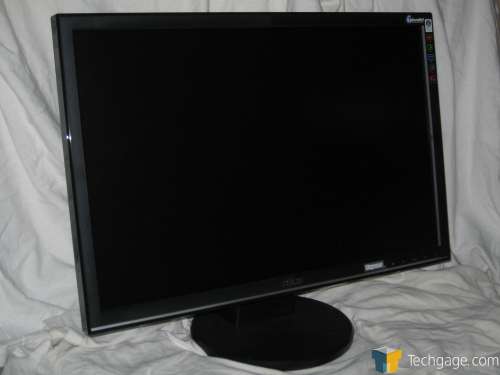- Qualcomm Launches Snapdragon 4 Gen 2 Mobile Platform
- AMD Launches Ryzen PRO 7000 Series Mobile & Desktop Platform
- Intel Launches Sleek Single-Slot Arc Pro A60 Workstation Graphics Card
- NVIDIA Announces Latest Ada Lovelace Additions: GeForce RTX 4060 Ti & RTX 4060
- Maxon Redshift With AMD Radeon GPU Rendering Support Now Available
ASUS VW222 22-inch Wide-Screen

The display market is chalked-full of models that fill up the quality spectrum, from sub-par up to high-end. The VW222 falls into the sub-par category, sadly, with overall poor color representation and noticeable screen-door effects, resulting in a model that should not be considered for purchase.
Page 1 – Introduction
|
|
March 16th Addendum: After reading the article, ASUS strongly believes that we received a defective unit. Their in-house units don’t display some of the problems laid out here, so we are receiving a fresh unit this week and will update the review with our latest thoughts. If contemplating this monitor, please check back to this review later this week! (March 16 follow-up: We’ve revised our Final Thoughts.
In my past reviews, I regret to say that I have ranted a lot about the current state of the display market. In short: What we buy now, for the most part, is crap. I hate to repeat it, but the unfortunate truth is it’s not going to change anytime soon.
Most monitors today are TN panels, and they’re popular for a reason. The main rational is the fact that they bring costs down – TN panels are far cheaper to manufacture. Since they’re cheap, they also allow for larger sizes, which are attractive for consumers. Compared to other types of panels, such as S-IPS or MVA, they also provide the fastest response times, which gamers and movie aficionados tend to prefer.
Beyond that, however, TN panels are in superior to every other alternative out there. Others do have different drawbacks (color shifting and black levels come to mind), but the infamous TN panels suffer from poor color representation (with most displays being 6-bit panels), smaller viewing angles, generally worse aspect ratios. Other common problems are more monitor-specific, so I don’t want to open that can of worms.
We have reviewed monitors with TN film panels in the past, and some have gotten decent scores. Some drawbacks are present across the board because there’s only so much that can be improved with the technology, but some decent performers still remain. So are all monitors using TN technology bad? Not necessarily. In most cases? Yes, yes they are.

I have to vent about my frustrations with this particular monitor. The ASUS 22″ VW222U highlights more of the issues with TN panels than I have ever faced with another monitor, and it’s a shame. It simply does nothing to remedy any of the technology’s faults.
Closer Look
Monitor packaging usually isn’t interesting. In this case, we have a box, a monitor, a DVI cable and VGA cable, a quick start guide and warranty card. The display comes with a simple stand that does nothing more than tilt, and the rubber feet don’t do a great job keeping everything steady when something is moved. It doesn’t sound too impressive so far, but we haven’t gotten to the important bits yet.
I don’t have much against the design considering there’s little to comment about it. The ASUS logo is seen at the bottom of the bezel with a silver strip below it, which the controls blend in with. I don’t personally care for the stickers placed on the right and bottom sides, and frankly that’s something that’s bugged me about certain companies. But to their defense, these stickers might be included with display and review models only, not retail units.
There doesn’t seem to be a myriad of ports here to choose from, you’ll only get DVI and VGA, along with a jack for the speaker. The inputs and power connector are located at opposite sides of the monitor. ASUS uses a simple yet effective means of organizing everything with a small hook connected to the stand, which seems to be a bit flimsy but shouldn’t break off unless you plan on frequently changing cables.
The overall construction is fairly solid, but I do feel that cheaper plastic was used to house the electronics. The backside and stand have a different feel than the bezel, and while I’m not crazy about it, it still works well together, so I don’t see it as much of a complaint.
My first impressions were very disappointing. Because of the monitor’s pixel pitch ratio, there was a visible “screen door” effect making each individual pixel visible at my usual viewing distance. The annoying viewing angles constantly pestered me, and I’ll get into the detail about the image quality in further sections. Because of the panel’s nature, viewing angles will be poor no matter what’s implemented, but for some reason the screen never looks uniform.
For example, the screen’s contrast ratio will look fine at eye-level, looking toward the top edge. However, the picture will look washed out when looking at the bottom, even when the point of view is unchanged. In my opinion, color shifting to this degree in unacceptable. I tried for days to get used to it, but the annoyance was too much to bear use it day-to-day without wanting to switch back.
This wouldn’t be much of a problem for people just picking up a monitor with no prior experience, but for someone with another display to compare it to, the problem instantly stands out.
|
|
Support our efforts! With ad revenue at an all-time low for written websites, we're relying more than ever on reader support to help us continue putting so much effort into this type of content. You can support us by becoming a Patron, or by using our Amazon shopping affiliate links listed through our articles. Thanks for your support!






